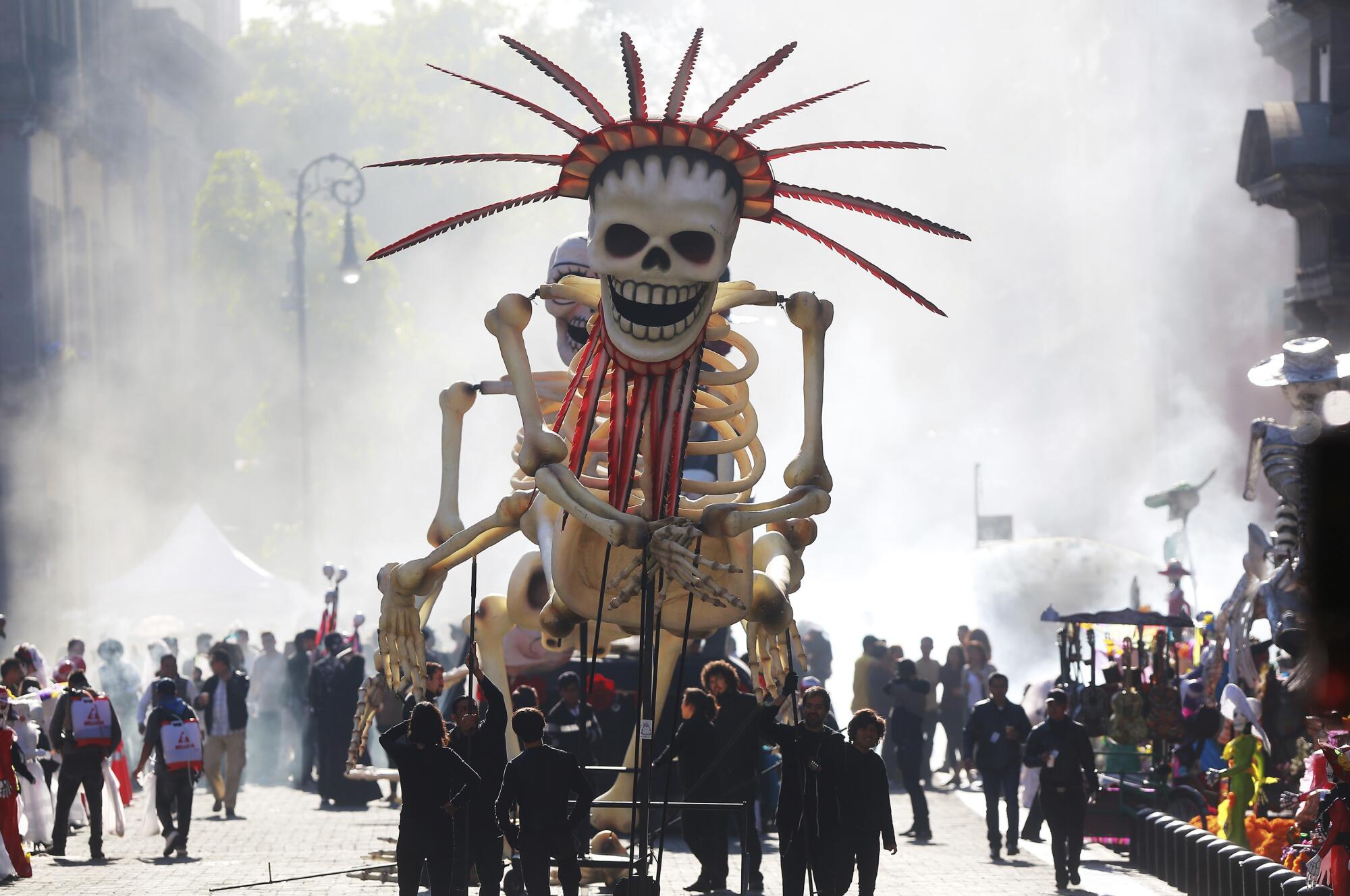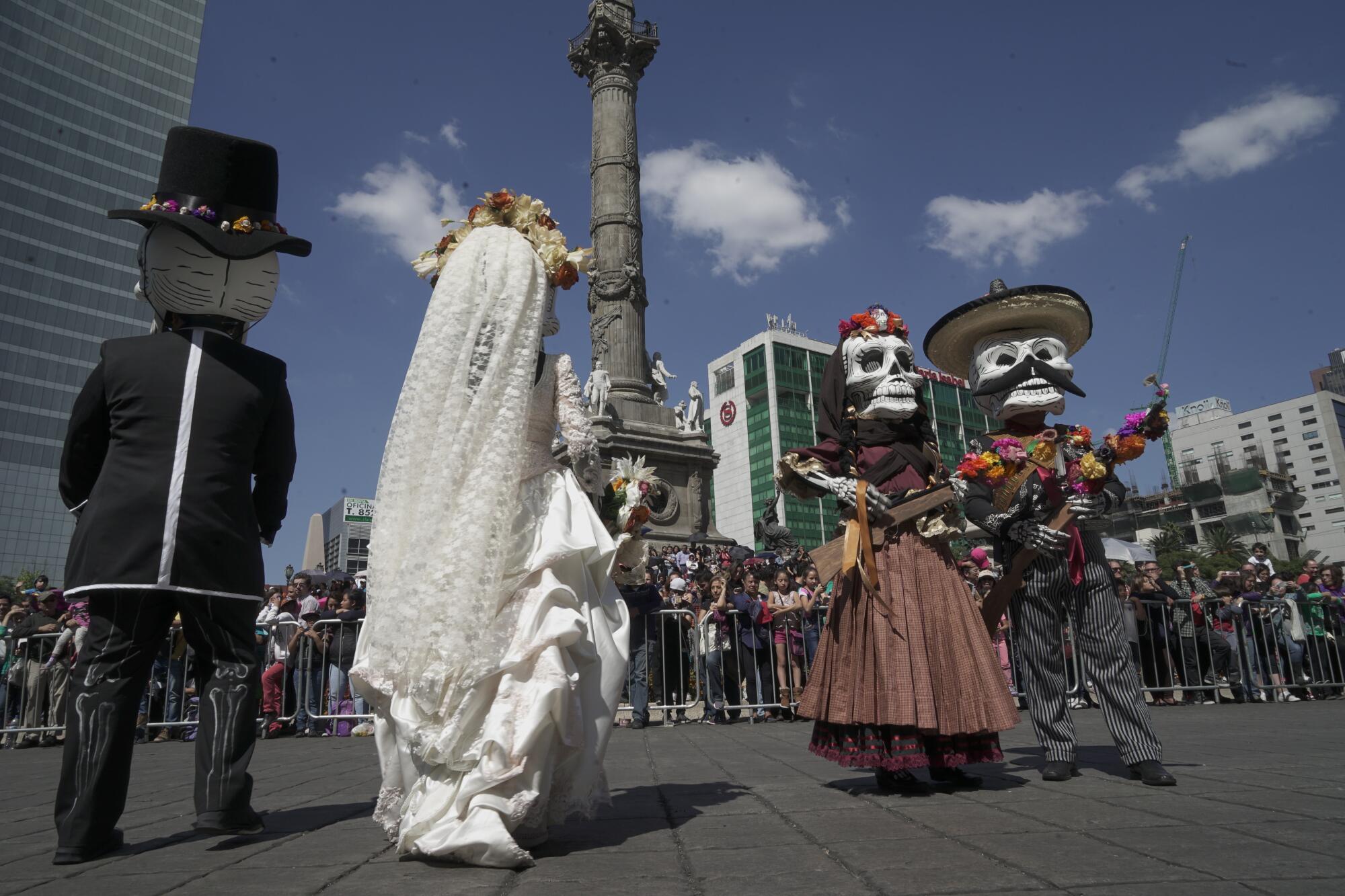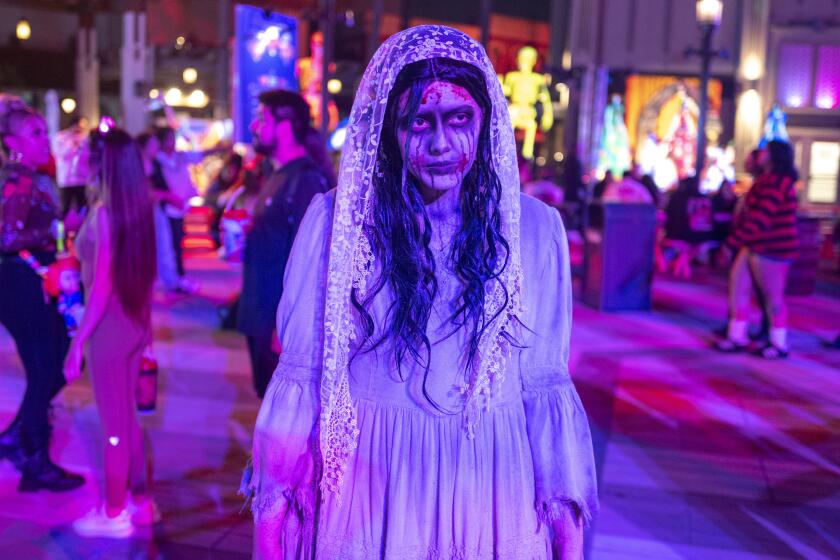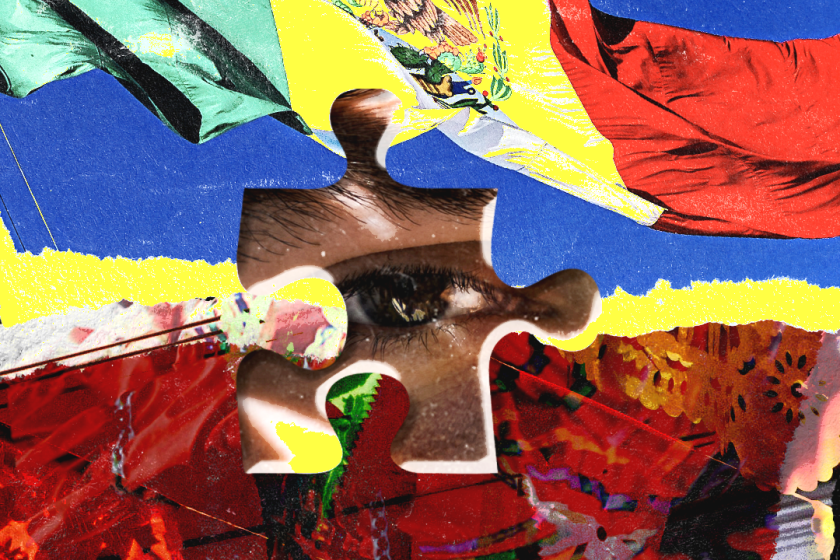
- Share via
On a beautiful street in Mexico City celebratory music plays, people line the sidewalks and giant, ornately adorned paper mache skeletons march toward the historic Zócalo. The crowd wears flowers in their hair and masks on their faces while children peruse the vendors’ sweets and toys.
This is Día de Muertos, a colorful, hallowed tradition where the ancestors are honored and welcomed back home. This specific parade, however, is a Hollywood invention. It’s the opening scene from “Spectre,” the 2015 James Bond movie, a scene so compelling it prompted Mexico City to actually start doing an annual Día de Muertos parade.

I got to see the first-ever Día de Muertos parade in Mexico City in 2016, where it appeared to be an immediate hit. I’d never seen such a crowded event in my life.
Many of the attendees, I learned from asking around, were from other states in Mexico and other Latin American countries, and came to see the spectacle of massive floats overflowing with colorful catrinas and alebrijes, figures we’ve come to associate with the holiday.
The parade made me rethink my preconceived notions about the sights and sounds I was being treated to. My family had come to witness a cultural practice with deep roots. But how much of it was a recent creation, and, more important, did it matter if it was?

It might surprise some to hear that the Día de Muertos parade stemmed from a single scene in a James Bond movie in 2015. Día de Muertos is, after all, a beloved tradition that many people hold close to their hearts. Indeed, the fact that it is a tradition, an heirloom of sorts, makes people protective, at times precious about it.
That it centers on the ancestors, a word that commands reverence, only adds to the idea that this holiday is an old, brittle thing that must be handled with great care. It’s understandable that some might view the parade through a cynical lens, as a tourist trap or as an inauthentic take on an ancient custom. “Fake,” others might say.
But I’m not one of those people. In fact, in the James-Bond-inspired Día de Muertos parade, I see something else entirely: a cypher for how culture is generated and, frankly, for how absurd it can be. I mean that in a good, fun way.
The Día de Muertos parade is a sumptuous, extravagant delight. The artistry on display is impressive, and it clearly was massively popular with locals and visitors. If anything, it’s in keeping with the ongoing text of the holiday, which has many aspects that are much younger than they first appear.
Latin American horror haunts visitors at Universal Studios’ Halloween Horror Nights in a new monstrous haunted house.
Take the iconic La Calavera Catrina, a smiling skeleton dressed in posh French clothes that we now associate so closely with Día de Muertos. She is practically the mascot, her face printed on tote bags and T-shirts. In truth, her image was created as a biting piece of social commentary.
In 20th century Mexico, master printmaker and lithographer José Guadalupe Posada created La Calavera Catrina to mock Mexican women who whiten their skin and wear European clothes to obscure their heritage. It was meant to humble those with similar aspirations.
I think, too, of the famed alebrijes. Those colorful, chimeric creatures that were featured in Pixar’s “Coco,” and which also become crucial components of Mexico City’s Día de Muertos festivities.
The Desfile y Concurso de Alebrijes Monumentales was first held in 2007, and it’s another festivity that I’ve been privileged to have witnessed many times. My favorite element of the event is that the alebrijes are often used as mediums to convey political messages and humor. As when a monstrous Trump alebrije led the parade in 2016.
According to a recent analysis from Pew Research, 78% of U.S. Hispanics say it is not necessary to speak Spanish in order to be considered Hispanic. Within the group of Latinos who don’t speak Spanish, however, 54% say they have been shamed because of it.
These crafts draw on Mexico’s many centuries of papier-mâché folk art, as well as Indigenous arts, but their most popular form today draws direct heritage from a single artist named Pedro Linares who, in the 1930s, was delirious with fever and claimed to have hallucinated the figures. They serve simultaneously as expressions of handicrafts that have existed in Mexico for many years, and the vivid hallucinations of “one guy.”
That, to me, is a lot of fun.
Of course, those who would turn a more critical eye to the nation of Mexico’s concentrated effort to make Día de Muertos a cultural institution would have plenty to point out.
While the holiday exists, as many things in Mexico do, as a combination of Indigenous practices with the Catholic Church, its most enduring form has historically been primarily practiced by rural Indigenous communities.
It was President Lázaro Cárdenas del Río who, in the 1930s, saw in the holiday a branding opportunity for a newly independent Mexico to lean into a romanticized idea of its Indigenous past to separate itself from Europe and Catholicism.
For speakers of some of the most commonly spoken native languages like Quechua, Nahuatl or Guarani, the conversation is less about whether you speak Spanish but rather how Indigenous languages are left out of the discussion.
Such practices fall roughly in line with the racialized myth-making, both popular and widely criticized, that holds that the Mexican people (typically defined here as excluding Indigenous communities that continue to exist within the country’s borders) are a new sort of people, born of Spanish and Indigenous blood to create a new raza.
There’s more to it than that, but, broadly speaking, there is a recurring phenomenon of nation-states utilizing the aesthetics and cultural output of their Indigenous peoples to assert a unique heritage and identity while those Indigenous peoples themselves often languish in the margins without resources and without the material support of the nation-state in question.
As for Día de Muertos, I have seen graveyards in rural communities overrun with tourists trampling over each other while gawking at the ofrendas and cultural practices that probably seem macabre or morbid to them.
With the success of films like “Coco” (a film I very much enjoy) and with the Mexican government continuing to promote the holiday as a cultural export, it’s likely that these trends will continue, and there is plenty to criticize and question there.
But there isn’t anything terribly unique happening in all this. Holidays and traditions common in the United States have a similar pedigree.
I think, for example, of Christmas and Easter. One thing the Catholic Church is going to do is see a popular festival and go: “That looks neat. Can we work it into our whole thing?”
Many Salvadorans are raised to believe there are no Black Salvadorans. Afro Salvadorans still face stigma, and even erasure.
The pagan roots of many of our holidays, and their previous associations with nature and harvests, are well known. It seems that there is interplay between native populations, empire, religion and nationalism. It’s how you get chocolate eggs and rabbits associated with the son of God’s triumph over death, I guess.
This was probably true in pre-Columbian Mexico as well.
To bring it back to our favorite holiday where we eat candy skulls, my favorite element of Día de Muertos, the thing that makes it a top-tier celebration, is the incorporation of humor. It’s both a solemn occasion, and an invitation to mock death, to laugh at it, to embrace it as an old friend who just walked into the bar. You’re supposed to rib death a bit. It doesn’t have to be so serious.
There is a lot of comfort to be had, here in a frightening, utterly industrialized world that alienates us both from each other and from ourselves, in the notion of unassailable tradition. It’s a beautiful thought, that there is something pure, something free of sin that sprang up from an older, better place, and we can commune with it if we are gentle enough with it, if we genuflect before it and we don’t let any outsiders get their grubby mitts on it.
But I am of the perhaps controversial belief that humans throughout the ages aren’t so radically different from one another in their impulses and behaviors. Don’t get me wrong, it’s good to be reverent of the past and to honor our roots. Traditions like Día de Muertos remind us where we come from, tell us to hold space for the people who’ve come before us and give us an opportunity to reflect on our collective past.
But it can be so tempting, when acknowledging ancestors, to place those figures on such a pedestal that it puts them at a glum remove, and we can come to forget that they, like us, were just people doing their best with what they had in an imperfect world.
We can come to forget that we, ourselves, will one day be ancestors to someone. We, too, have been gifted with the ability to make new traditions and to draw from the wisdom of the past in order to shape and generate the world to come.
Día de Muertos is a celebration of our deceased loved ones, but it’s also a celebration of the present, of movement, of transition. It tells us that death is nothing to fear because death is simply another phase of life. “Things change,” the holiday says, “we don’t have to be afraid of that.”
And so, as Día de Muertos continues its march through the streets of time, entering U.S. cities and decor aisles in Target, I try to remember this core lesson. Human life has always been a chaotic, absurd, turbulent, joyful affair.
Sometimes, you just have to laugh.
John Paul Brammer is a columnist, author, illustrator and content creator based in Brooklyn. He is the author of ”Hola Papi: How to Come Out in a Walmart Parking Lot and Other Life Lessons” based on his successful advice column. He has written for outlets like the Guardian, NBC News and the Washington Post. He will write a weekly essay for De Los.
More to Read
The Latinx experience chronicled
Get the Latinx Files newsletter for stories that capture the multitudes within our communities.
You may occasionally receive promotional content from the Los Angeles Times.










